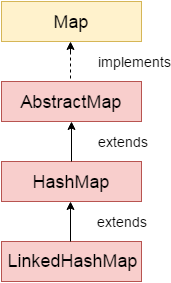128
Java LinkedHashMap class

Java LinkedHashMap class is Hashtable and Linked list implementation of the Map interface, with predictable iteration order. It inherits HashMap class and implements the Map interface.
Points to remember
- Java LinkedHashMap contains values based on the key.
- Java LinkedHashMap contains unique elements.
- Java LinkedHashMap may have one null key and multiple null values.
- Java LinkedHashMap is non synchronized.
- Java LinkedHashMap maintains insertion order.
- The initial default capacity of Java HashMap class is 16 with a load factor of 0.75.
LinkedHashMap class declaration
Let’s see the declaration for java.util.LinkedHashMap class.
LinkedHashMap class Parameters
Let’s see the Parameters for java.util.LinkedHashMap class.
- K: It is the type of keys maintained by this map.
- V: It is the type of mapped values.
Constructors of Java LinkedHashMap class
| Constructor | Description |
|---|---|
| LinkedHashMap() | It is used to construct a default LinkedHashMap. |
| LinkedHashMap(int capacity) | It is used to initialize a LinkedHashMap with the given capacity. |
| LinkedHashMap(int capacity, float loadFactor) | It is used to initialize both the capacity and the load factor. |
| LinkedHashMap(int capacity, float loadFactor, boolean accessOrder) | It is used to initialize both the capacity and the load factor with specified ordering mode. |
| LinkedHashMap(Map<? extends K,? extends V> m) | It is used to initialize the LinkedHashMap with the elements from the given Map class m. |
Methods of Java LinkedHashMap class
| Method | Description |
|---|---|
| V get(Object key) | It returns the value to which the specified key is mapped. |
| void clear() | It removes all the key-value pairs from a map. |
| boolean containsValue(Object value) | It returns true if the map maps one or more keys to the specified value. |
| Set<Map.Entry<K,V>> entrySet() | It returns a Set view of the mappings contained in the map. |
| void forEach(BiConsumer<? super K,? super V> action) | It performs the given action for each entry in the map until all entries have been processed or the action throws an exception. |
| V getOrDefault(Object key, V defaultValue) | It returns the value to which the specified key is mapped or defaultValue if this map contains no mapping for the key. |
| Set<K> keySet() | It returns a Set view of the keys contained in the map |
| protected boolean removeEldestEntry(Map.Entry<K,V> eldest) | It returns true on removing its eldest entry. |
| void replaceAll(BiFunction<? super K,? super V,? extends V> function) | It replaces each entry’s value with the result of invoking the given function on that entry until all entries have been processed or the function throws an exception. |
| Collection<V> values() | It returns a Collection view of the values contained in this map. |
Java LinkedHashMap Example
Output:100 Amit 101 Vijay 102 Rahul
Java LinkedHashMap Example: Key-Value pair
Keys: [100, 101, 102] Values: [Amit, Vijay, Rahul] Key-Value pairs: [100=Amit, 101=Vijay, 102=Rahul]
Java LinkedHashMap Example:remove()
Output:
Before invoking remove() method: {101=Amit, 102=Vijay, 103=Rahul} After invoking remove() method: {101=Amit, 103=Rahul} Java LinkedHashMap Example: Book
Output:
2 Details: 102 Data Communications & Networking Forouzan Mc Graw Hill 4 1 Details: 101 Let us C Yashwant Kanetkar BPB 8 3 Details: 103 Operating System Galvin Wiley 6
Next TopicJava TreeMap class
